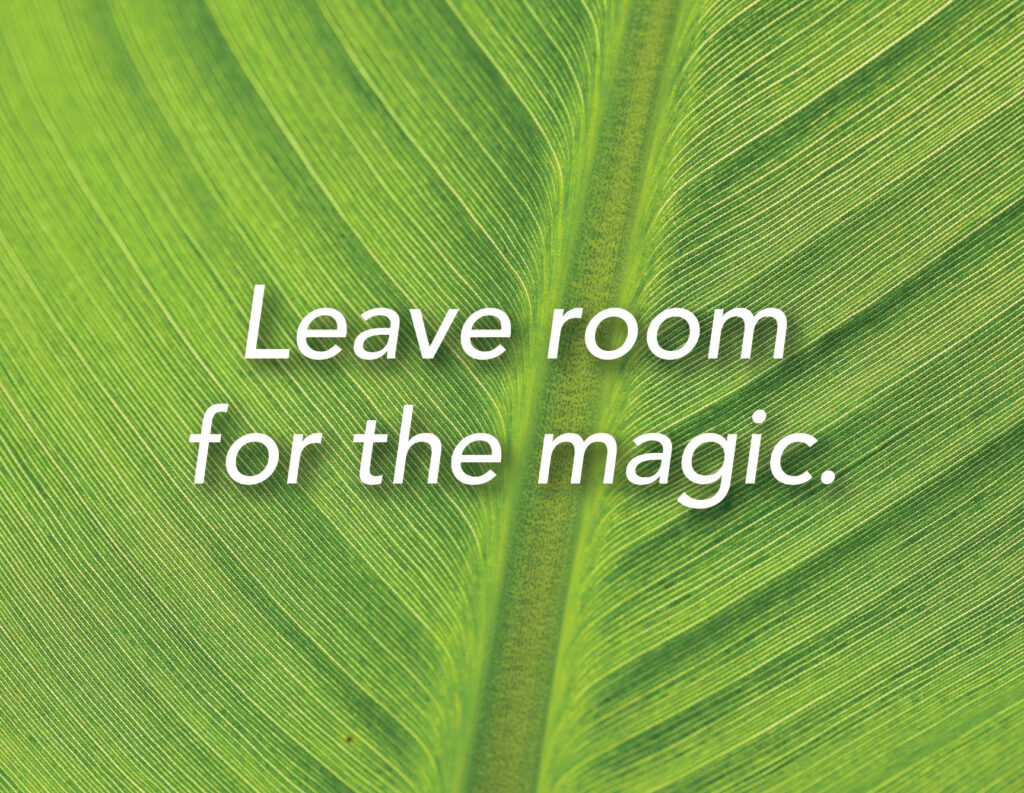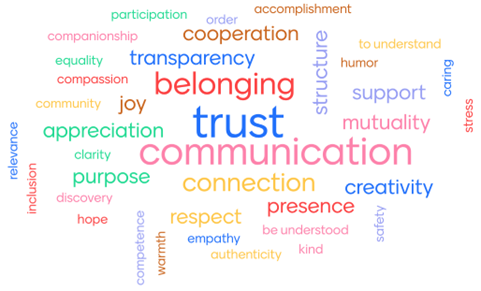Aug 29, 2023
A colleague from Kansas recently told me that she had received some pressure to “cover more material” in order to “make the most” of the professional development investment.

“Yikes!” I said, “That is so contrary to all we know about how humans learn.”
“Don’t give into the pressure,” I added, “You have to leave room for the magic.”
I told her about the GLP postcard taped right next to my computer screen that says, “Leave room for magic.” [see image to the right] I shared how this short sentence is my strongest defense against our culture’s mantra of “more is better.”
What do we mean by “magic”?
Just as a magician can evoke wonder and awe with a slight of hand, we as facilitators can do the same by creating the conditions for participants to make their own “magic.” For me magic, in the context of professional learning, is about discovery and agency. If I’ve done my job well, participants will feel that they were meaningfully and actively engaged in their own learning adventure, not led through it by the nose.
When I first started this work, I thought all I had to do was create engaging learning activities and leave lots of time for questions and insights. But over time I learned that no matter how cool my learning activity was, or how much time I left for discussion and questions, if I didn’t take the time to co-create a brave space for learning, magic was much less likely to happen.
How do we create the conditions for “magic”?
I have three responsibilities when it comes to creating the conditions for magic to happen:
- find out what it means to each group I serve;
- enlist them as co-creators of the conditions in which it will happen; and,
- create time and space for the magic to actually happen.
To this end, one of my favorite questions to ask in my Learning Needs and Resources Assessment (LNRA) is, “Reflect on a learning experience when you felt deeply engaged and excited to learn. What top three needs were being met for you to be so deeply engaged?” I provide them with a list of human needs so they can be specific.
Tip #1: In the LNRA uncover the human needs essential to learning for each group.
Time and time again, the needs they name align with the six principles of Dialogue Education (DE): safety, respect, inclusion, relevance, immediacy, engagement. So our starting place for magic-making, always, is to begin with training designs where those principles are brought to life. This is ongoing work best supported by a fellow DE-trained facilitator who can review your design through that lens.
Tip #2: If you want to make magic, begin by carefully bringing the six DE principles to life in your training.
While attending well to these principles creates the kind of magic we’ve come to expect from DE, we can do more. And the kind of “more” I am talking about is desperately needed in our world. This “more” comes from slowing down to attend to the specific human needs in the room. When human needs are met, people feel grounded, safe and fully present. And when a room full of people feel grounded, safe and fully present amazing, magical things happen. But the key to constructing this brave space is that it is done together.
I do this first by showing the group all the needs they listed in the LNRA, usually as a Word Cloud, and ask them to turn to a partner to share for two minutes each the learning experience they had reflected on and how their needs were met. Next, I use a collaborative process and some chart paper (or in a worksheet) to develop a set of strategies to collectively meet those needs during our time together. People then take on roles to ensure the strategies are used. One person might be the person to remind us to take a movement break to meet the need for “movement.” Someone else might volunteer to make sure we stick to our time to meet the need for “structure.” We then agree on a signal or phrase to indicate to the group or facilitator when a need is not being met. One of my favorites is the time-out signal with the phrase, “Needs Check.”

Tip #3: Once you are in the room together, build concrete strategies you can use as a group to meet those needs and how to hold ourselves accountable to those strategies.
Sharing the job of meeting the needs of our learners has two major benefits:
First, once a strong and brave space is created and held collectively, we can loosen our grip on the steering wheel. By sharing responsibility, the leader has more time and space to attune to the pulse of learning in the room and adjust pacing, timing and content in a way that is responsive rather than prescriptive. “Magic” does not happen in spaces where the presenter feels responsible for everyone and everything. There must be room for them to be at their best, most inspired and creative.
Second, when participants are invited to value their own needs and the needs of the group and then given the opportunity to co-create a brave space, they invariably step into it! In other words, as I invite them to take responsibility for their own and each other’s needs they respond by bringing the same energy to their learning. They develop agency!
How do we “leave room for the magic”?
You might be asking, “How can I leave room for magic if I take all this time to build brave space?” The time it takes is worth the magic that results!
The process I’ve described can take as little as 20 minutes or as long as an hour. If the group is large or I am only seeing them once, I will offer some strategies used by past groups that address the most common needs and use a proposal consensus process. If it’s a group that will get together routinely over a period of time, I will spend more time building and revising the strategies together. I will then check in on how those needs were met in my exit ticket every time we meet. Even if only 15 minutes is spent reflecting on and sharing needs, a braver space will result.
After 20 years of facilitating, I still have “Leave room for the magic” on my wall. Why? Because creating the conditions for the risky endeavor of real learning is of no use if I don’t build in the actual time and space for people to experience agency and discovery. And I am still prone to forgetting. Like my colleague, I still cave into my clients’ requests to “cover” more material. But now, even when I do, participants will often remind me, “Can we have some time to silently write some notes?” or “Can we have more time in our groups?” These requests are evidence I have done my job well and the participants have become agents in their own learning. Magic will always arise out of those conditions.
What do you do to leave room for the magic?
Annie O’Shaughnessy, M.Ed. is a Certified Dialogue Education Teacher with GLP. After a career as an educator in public, private and alternative schools, Annie began offering trainings and seminars across the state and country in restorative practices, mindfulness and trauma informed practices through her organization True Nature Teaching. Her many years of experience as a teacher, advanced training in both trauma informed and restorative practices, and a M.Ed. in Mindfulness for Educators prepared her well to be of benefit to students, educators and schools across the state and nationally. She is now the founder and coordinator of the Holistic Restorative Education Certificate Program at Saint Michael’s College and the co-founder of Starling Collaborative, a nonprofit founded to support schools and organizations across the country to implement holistic restorative approaches.
Here are other GLP resources you may be interested in…



